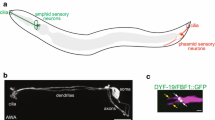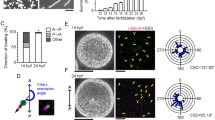Summary
The basal apparatus of embryonic cells of the sea urchin Lytechinus pictus was examined by transmission electron microscopy and compared with the basal apparatus of other metazoan cells. The basal apparatus in these cells is associated with a specialized region of the apical cell surface that is encircled by a ring of microvilli. The basal apparatus includes several features that are common to all ciliated cells, including a basal body, basal foot, basal foot cap, and striated rootlet. However, a component not seen in the basal apparatus of other species has been observed in these cells. This structure is continuous with the striated rootlet, and its ultrastructure indicates that it is composed of the same components as the rootlet. This structure extends from the junction of the basal body and striated rootlet to the cortical region that surrounds the basal body. Based on its morphology and position, this structure is referred to as a striated side-arm. The striated side-arm is always aligned in the plane of the basal foot. Thus, both of these structures extend from the basal body in the plane of the effective stroke. It is suggested that the striated side-arm serves to stabilize the basal apparatus against force exerted by the cilium.
Similar content being viewed by others
References
Anderson RGW (1972) The three dimensional structure of the basal body from the rhesus monkey oviduct. J Cell Biol 54:246–265
Anderson RGW (1974) Isolation of ciliated or unciliated basal bodies from the rabbit oviduct. J Cell Biol 60:393–404
Anstrom JA (1989) Sea urchin primary mesenchyme cells: ingression occurs independent of microtubules. Dev Biol 131:269–275
Barak LS, Yocum RR, Nothnagel EA, Webb WW (1980) Fluorescence staining of the actin cytoskeleton in living cells with 7-nitrobenz-2-oxa-1, 3-diazole phallacidin. Proc Natl Acad Sci USA 77:980–984
Baron AT, Salisbury JL (1988) Identification and localization of a novel, cytoskeletal, centrosome-associated protein in PtK2 cells. J Cell Biol 107:2669–2678
Cavanaugh GM (1956) Formulae and methods, 5th edn. Marine Biological Laboratory, Woods Hole, Mass
Davidson EH (1986) Gene activity in early development. Academic Press, New York
Ettensohn CA (1984) Primary invagination of the vegetal plate during sea urchin gastrulation. Am Zool 24:571–588
Fawcett DW, Porter KR (1954) A study of the fine structure of ciliated epithelia. J Morphol 94:221–281
Frisch D, Farbman AI (1968) Development of order during ciliogenesis Anat Rec 162:221–231
Gibbins JR, Tilney LG, Porter KR (1969) Microtubules in the formation and development of the primary mesenchyme in Arbacia punctulata. I. The distribution of microtubules. J Cell Biol 41:201–226
Gibbons IR (1961) The relationship between the fine structure and direction of beat in gill cilia of a lamellibranch mollusc. J Cell Biol 11:179–205
Hard R, Rieder CL (1983) Mucociliary transport in newt lungs: The ultrastructure of the ciliary apparatus in isolated epithelial sheets and in functional triton extracted models. Tissue Cell 15:227–243
Holley MC (1984) The ciliary basal apparatus is adapted to the structure and mechanics of the epithelium. Tissue Cell 16:287–310
Holley MC (1985) Adaptation of a ciliary basal apparatus to cell shape changes in a contractile epithelium. Tissue Cell 17:321–334
Pitelka DR (1974) Basal bodies and root structures. In: Sleigh MA (ed) Cilia and flagella. Academic Press, New York, pp 437–469
Reed W, Avolio J, Satir P (1984) Thecytoskeleton of the apical border of the lateral cells of freshwater mussel gill: structural integration of microtubule and actin filament-based organelles. J Cell Sci 68:1–33
Salisbury JL, Baron AT, Surek B, Melkonian M (1984) Striated flagellar roots: isolation and partial characterization of a calcium-modulated contractile organelle. J Cell Biol 99:962–970
Salisbury JL, Baron AT, Coling VE, Martindale VE, Sanders MA (1986) Calcium-modulated contractile proteins associated with the eucaryotic centrosome. Cell Motil Cytoskeleton 6:193–197
Sleigh MA, Silvester NR (1983) Anchorage functions of the basal apparatus of cilia. Submicrosc Cytol 15:101–104
Stephens RE (1975) The basal apparatus. Mass isolation from the molluscan ciliated gill epithelium and a preliminary characterization of striated rootlets. J Cell Biol 64:408–420
Author information
Authors and Affiliations
Rights and permissions
About this article
Cite this article
Anstrom, J.A. Organization of the ciliary basal apparatus in embryonic cells of the sea urchin, Lytechinus pictus . Cell Tissue Res 269, 305–313 (1992). https://doi.org/10.1007/BF00319622
Received:
Accepted:
Issue Date:
DOI: https://doi.org/10.1007/BF00319622




